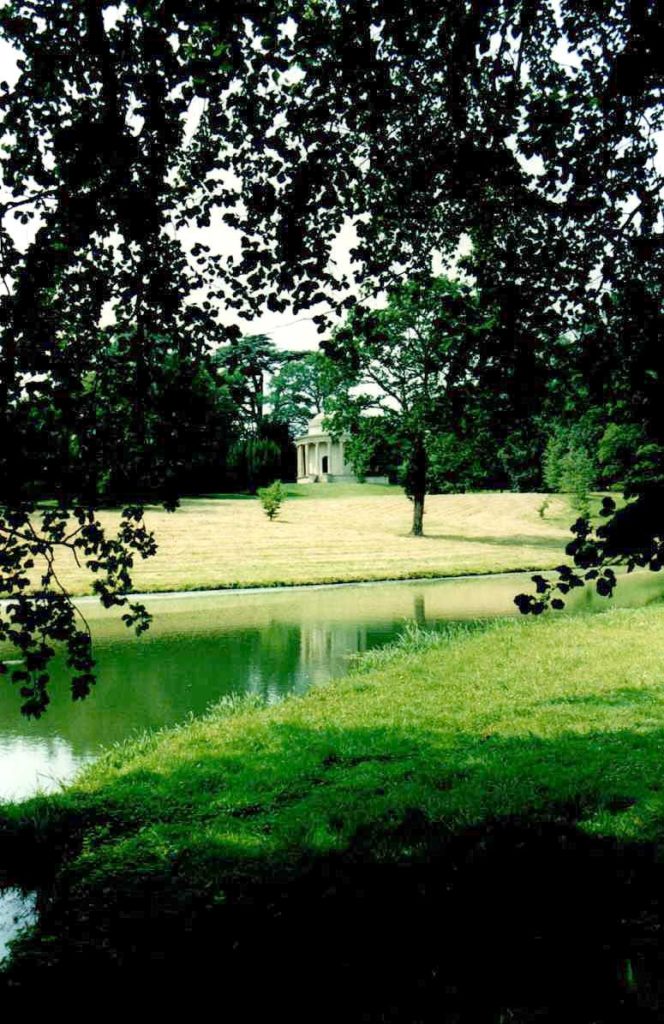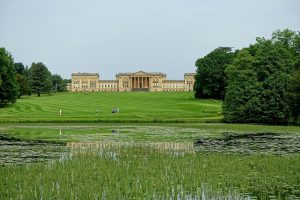 ‘Unforgettable Gardens’
‘Unforgettable Gardens’
‘The Elysian Fields’ at Stowe – a personal view
If I think of the designed landscape at Stowe, the Elysian Fields come directly to mind. They seem to me to embody the essence of this vast landscape.
The huge landscape at Stowe began, not surprisingly, with the long axis which was laid out by Charles Bridgman for Viscount Cobham (owner 1697- 1749) leading southwards from the mansion to what was originally an octagonal basin and taking in an area westwards out to Vanbrugh’s Rotundo of 1720/1 on a sculpted mound (1720 plan by Bridgeman). The next phase extended even further to the west, enclosing an area of pasture and a large lake bounded by raised walks enlivened by temples at changes of direction. These earliest layouts were in the strict geometrical style fashionable at the time.

Soon there came a growing appreciation of the possibilities provided by the accident of terrain and this is where the significance of the Elysian Fields is derived. Immediately to the east of the long axis was a valley that originally contained the village of Stowe which had been cleared (except for its medieval church). Into this William Kent placed a sequence of serpentine pools descending to the south, parallel with the main axis, and populated it with an astonishing and disparate family of monuments. This coincided with Viscount Cobham’s political break with Walpole, leading to his withdrawal to Stowe in 1733 to concentrate on gardening. The Elysian Fields were used by Lord Cobham to underline his political opposition to Walpole and his support for Frederick, the then Prince of Wales (d. 1751). This bygone political subtext was the subtle piece of grit that created the pearl – the beauty and delight of the Elysian Fields which is regarded as one of Kent’s masterpieces, and which has happily survived with little alteration since its creation.
Imagine a gentle valley with water meandering quietly between low grassy banks backed and enclosed by mature planting through which peep classical monuments. This creates a sequence of subjects ready for the brush of Claude Lorrain except in this instance there are no classical or biblical figures but only entranced visitors. The monuments on the west stand on higher ground than those on the east and here the perfect ‘Temple to Ancient Virtue’ (based closely on the Temple of Vesta at Tivoli) dominates the valley. It was built in 1736-7 but was designed earlier by Kent. Copies of four statues in the cool interior commemorate great heroes of Greece (the home of democracy and liberty – as opposed to the evils of the Roman empire).

Just to the north is a different kind of memorial to another and more up-to-date hero, Captain Grenville (Lord Cobham’s nephew who was killed in 1747 in a sea battle with the French). This monument is a rostral column topped by a Muse who (according to the inscription) forbids ‘Heroic Worth to die’. There are enchanting views across the water up to the column on its bank and to its surrounding trees.Opposite the temple of Ancient Virtue on the east side of the water is the fascinating and unique ‘Temple of British Worthies’. This stone exedra consists of a sequence of niches each containing a bust of a famous personage. This was the first monument to be erected in the Elysian Fields by Kent and dates from 1734-5 (like the other temple it had been designed earlier – in this case for Lord Burlington’s Chiswick).
Close to the Temple of Ancient Virtue was the satirical ‘Temple of Modern Virtue’, a ruin possibly contrived out of the remains of a former village building, but now almost entirely lost.
The water running through the Elysian Fields was directed at the foot of the valley south-westwards into the Octagonal Basin.
The eastern extension of the Stowe landscape did not stop with the Elysian Fields. Further land was taken in to mirror the work done on the west side with the ‘Hawkwell Fields’ to the east being surrounded by another raised walk with further temples (see the Bridgeman plan of 1739).
If the Elysian Fields are truly the abode of the blessed, singled out by the gods for eternal happiness, they could not do better than in this most intimate part of the remarkable designed landscape at Stowe.
Geoff Huntingford (acknowledging help from Michael Bevington and John Martin Robinson)

